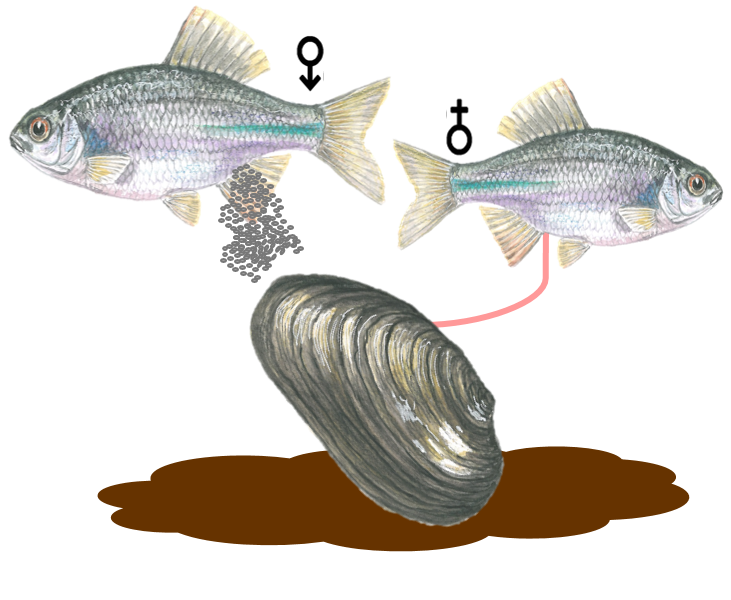Ribe
Naravno ohranjene reke in potoki so življenjski prostor nekaterih redkih in ogroženih vrst rib, ki so iz marsikaterega potoka drugod po Sloveniji že izginile. Medje sodijo tudi tri naravovarstveno pomembne vrste.
Pezdirk (Rhodeus sericeus amarus) ima še posebno zanimivo biologijo. Ta mala, do 9 cm velika riba namreč za svoj življenjski krog potrebuje prisotnost školjke potočni škržek (Unio crassus). Razmnoževanje vrste je izključno odvisno od prisotnosti te školjke, v katero samica pezdirka s posebnim organom (ovipozitor) v školjko odloži ikre (jajčeca). Medtem samec pezdirka semensko tekočino izbrizga v bližini školjke in ko školjka posrka vodo pride v njeni notranjosti do oploditve. V varni notranjosti školjke nato prvih nekaj tednov živijo mladi pezdirki, kjer so zaščiteni pred plenilci.

Shematski prikaz razmnoževanja pezdirka ![]() J. Mikuletič
J. Mikuletič
Pezdirk vrne uslugo školjki, saj ličinke školjke živijo v škrgah pezdirka. Tako pezdirk kot potočni škržek sta kvalifikacijski vrsti območja Natura 2000 Goričko. V preteklosti so samice pezdirka uporabljali kot "test nosečnosti", saj se je ob vbrizganju urina noseče ženske pri samici sprožila cevka za odlaganje iker. Pezdirk ima visoko in bočno stisnjeno telo z majhno glavo, boki so živo kovinsko obarvani ter od sredine telesa do repne plavuti poteka modra črta. Hrani se z rastlinami, redko tudi s črvi in ličinkami žuželk.
Navadna nežica (Cobitis elongatoides) je majhna, do 15 cm dolga in 15 g težka riba. Telo je belorumene barve z rjavimi pegami po hrbtu (12-19 peg) in bokih (10-13 peg) ter 6 izrastki okoli ust. Prehranjuje se z drobnimi vodnimi nevretenčarji in odmrlimi rastlinskimi delci. Življenjski prostor nežice so srednje do hitro tekoče čiste plitve vode s peščenim dnom.
Ukrajinskega potočnega piškurja (Eudontomyzon mariae) zlahka prepoznamo po do 22 cm dolgem podolgovatem, kačastem telesu na koncu katerega je glava z usti na sredini. Okoli ust je prisesna plošča z vsaj nekaj zobci. Razvoj ličinke traja 3,5 do 4,5 let in nato še 10 mesecev, da odrasla žival spolno dozori. Odrasla žival se nato drsti tako, da samica odloži ikre v plitva gnezda, ki jih je pred tem v dno izkopal samec. Po drsti poginejo in tako je življenjska doba spolno zrele odrasle živali le dva do tri mesece. Ličinke se hranijo z organskim drobirjem in mikroorganizmi. Piškurji živijo v nižinskih rekah in potokih, kjer so zakopani v mehko, peščeno muljasto dno, bogato z organskimi ostanki. Na Goričkem živi v reki Veliki in Mali Krki, Peskovskemu in Dolenskem potoku, Mačkovskem, Gračkem in Lukaj potoku. Več informacij...
Na vodnih zadrževalnikih (Ledavsko, Hodoško, Križevsko in Bukovniško jezero) se sicer izvaja ribolov na babuško, klena, koreselja, krapa, linja, ostriža, rdečeoko, rdečeperko, smuča, soma, ščuko in zeleniko. V teh stoječih vodah živijo tudi tujerodne vrste kot je ameriškega somič.








